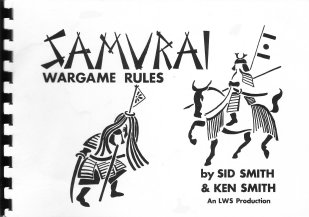

Samurai Wargame Rules Review
 |
 |
 |
 |
 |
 |
 |
 |
 |
 |
 |

Rules by Sid Smith & Ken Smith / London Wargames Section
A nostalgic look at “Samurai Wargame Rules” by LWS
When I first joined a wargames club in the early 1970s, most of the games were Napoleonic or Ancient period affairs using the club’s own house rules. Occasionally, some brave individual would try, unsuccessfully, to introduce the masses to such diverse periods as WWII, American Civil War or even Seven Years War. My own interests were firmly set in the “ancients” quarter, having been fascinated by the Classical Greek world from an early age. It was only natural that I would end up painting hordes of hoplites, phalangites and peltasts…and Persians.
On one occasion, I noticed a group of the club’s “elite” members huddled in a corner of the main hall. Unusually, they were not partaking in the main event; a Napoleonic bash. They had set up a 4’ by 4’ table with lots of small groups of unusual figures. Hovering around for a better look, I noticed that some of the figures were unmistakably samurai warriors. Excitedly, I enquired about the game but was greeted with an icy response. It appeared that, being a teenager, I was of too low a standing to be considered for participation in such a prestigious event. I did learn, however, that the figures were from a new range of Miniature Figurines and that the rules had been cunningly crafted by the figures’ owner – well, hacked out on an old typewriter actually. I knew then that I had to have some of these figures. Indeed, how could anyone resist the mystique of feudal Japan and samurai warfare?
Shortly after this, my first eagerly awaited samurai figures arrived. Within hours they were undercoated and ready for painting. Although I didn’t have any “uniform” details, other than a couple of pictures in Military Modelling magazine, I reckoned that just about any colours would be appropriate. My twenty or so figures were soon sitting in front of me, brightly coloured and ready for action. Except that I didn’t have any rules. The club set never resurfaced, like so many before it, so it looked like I would have to write my own. Being 1974, books on the samurai were few and far between; my small local library wasn’t exactly bursting with books on oriental warfare. All very frustrating. Maybe I should have settled for a British Napoleonic force instead.
Just as I was about to give up hope, an ad in Military Modelling magazine caught my eye. “Samurai Wargame Rules” by London Wargames Section, price 60 pence (well it was 1974!). I just had to order this set of rules immediately. A week or so later, I was the delighted owner of an 18 page A5 rules booklet (not including covers and playsheet) for skirmishes of the period 1100 – 1500, although rules were also given for firearms. Perfect! The rules were intended for 25mm figures (I don’t think 15s had been invented when the rules were written) and required normal and average dice (popular at the time).
Each figure had to be identifiable (I painted a small number on the base) as wounds, ammunition and other characteristics had to be recorded during the game. The main troop types defined are Samurai, Chugen and Ashigaru, which are further distinguished by weapons and armour. As you would expect, only samurai can be mounted. The figures were organised into units, each of which had to include a leader, and these units were then issued a simple tactical order such as “raid house 2” or “Lay in ambush at the crossroads”.
The sequence of play essentially boils down to writing any new orders, missile fire, movement, melee and lastly, morale. All combat and morale calculations only involve rolling one or two dice, adding a few tactical factors and consulting a simple table, so the game moved very quickly. A warrior would die after receiving 6 wounds, his mount after 4 – yes, you can kill the poor pony!
The rules conclude with some “competition rules” (which is really a strange scenario with each side raiding each others houses) and some brief appendices describing samurai, extending the rules for Mongols and a few common Japanese terms.
This was probably one of my most utilised set of wargames rules ever, (and I’ve got a few!) so that must say something – even if I haven’t used them for nearly thirty years! Maybe I’ll just go now and blow the dust off the old Minifigs…
Review by Ian Duncan. September 2004

